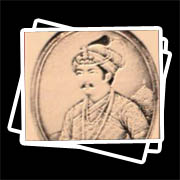| |
History
Gold has played a major role in civilization since the beginning of recorded history. For centuries, it has been the only universally accepted means of exchange, providing security for individuals and for individuals and countries in times of war and peace. Today it is helping millions of people throughout the world live longer, healthier, happier and more productive lives. It has enabled us to conquer space----- and to lead the world in new medical, electronic and environmental technologies. And this ancient metal is at the heart of today's high tech communications.
Mumtaz Mehal, Wife of Shah Jehan :
Miniature Painted on Ivory in 19th AD.
In her ears.................Oh! Poet! You are moon-enraptured, beguiled.
(Punjabi_Fazal Shah, 19th cent.)
MUMTAZ MEHAL AND EMPEROR JAHANGIR |
|
|
|
|
|
|
|
|
|
 |
|
|
|
|
|
| The Mughal emperors celebrated their birthdays, both lunar and solar, by holding a grand feast, the highlight of which was the weighing of the king's person against gold and silver. Nur Nehan presented her husband, Jehangir, with gifts on his solar birthday on the 2nd of September 1621. "At the end of the entertainment, the offerings she (Nur Jehan) had prepared for me were produced.Of the jewels, jewelled ornaments, clothes and various rarities I selected what I approved". |
|
|
|
|
|
|
|
|
|
|
|
|
|
|
|
Empress Nur Jehan Mughal Miniature Painted after the Western style.19th centuryselected what I approved".
GIRDLES OF BEADS FROM MOENJODARO |
|
|
|
|
|
|
|
|
|
|
|
All the necklaces worn by the women of Moenjodaro consisted of beads in a variety of colours, shapes and materials. More common ornaments, the women of Moenjodaro wore Links were forged by trade between the Indus Valley people and those of Egypt and Mesopotamia, thus indirectly also with the West. Although the civilization of the Indus Valley is famed for its scientific urban planning, we cannot ignore the skill and extraordinary craftsmanship displayed in the ornaments, which is the basis of our traditional and contemporary jewellery.
FIGUIRINE OF GODDESS TERRACOTA |
|
|
|
|
|
|
|
|
|
|
|
The Terracotta figurines of Mother Goddesses are bedecked with heavy jewellery, entwined with girdles, rows of necklaces and elaborate head-dresses. The steatite bust of a nobleman or high priest wearing a fillet on his forehead and an armlet of similar decoration is typical of jewellery depicted on figurines, actual ornaments provide us with rich examples of the skill of the goldsmiths and evidence of the multitudinous variety of forms and materials used by people thousands of years ago.
THE BLENDED CULTURE OF TAXILA |
|
|
|
|
|
|
|
|
|
|
|
|
|
|
|
| The female figure holding a mirror Gandhara; the two coins from Taxila)The epoch illuminated by the discovery of historical and cultural aspects of the centuries between 500 BC and 500 AD in the northwesterly sector of Pakistan. This region was known as Gandhara(modern Kabul, Swat, Peshawar and Rawalpindi).These 1000 years cover the history of many nations, Persians, Greeks, Scythians, Parthians, Hindus, Bactrians and Kushans. Contact with these cultures was echoed in many fields.It is evident in the ornamental motifs and forms in architecture, sculpture and the jewellery of the various periods in Taxila's colourful past. As always, it was the ruling class who created the vogue for the art forms they brought from their home country, while the local population remained faithful to the culture of their ancestors.
Taxila was a town with a blend of many cultures and peoples. The dresses and ornaments on the sculpted figures bear evidence of a cosmopoltan city.
THE END OF TAXILA |
|
|
|
|
|
|
|
|
|
|
|
| The vogue in gem studded jewellery reached its height in the first century AD and was a result of the Parthian occupation. It was of two kinds. In one, the gem or paste was inclosed in small compartments or paste was enclosed in small comartments or cloisons. This is an early example of Kundan, a similar technique which reached its height during the Mughul period. Alternately, box settings were used. Stones found in the jewellery of that period include lapis-lazuli, malachite, rock crystal, garnets, carnelian and chert. According to the Chinese traveller Hsuan Tsang White Huns overran the country in 455AD. With this unvasion came the end of Taxila. In the 7th century AD there was no longer any evidence of the bustling trade centre, only the university remained. (At the top left Chines traveller Hsuan Tsan, In the middle Amphora type earring bearing dolphins and inlaid with truquoise, At the top right Bold necklace, 31 pieces, of two alternating patterns, ornamented with granulation and cloisonne) |
|
|
|
|
|
|
|
|
|
|
|
Tombstone for woman's grave Chaukandi, Sindh.
16th-- 18th Century AD.
Gold Plated Budhistva |
|
|
|
|
|
|
|
|
|
|
|
| Karas and Bangles in Nauratan Setting |
|
|
|
|
|
|
|
|
|
|
|
Anklets Found in Taxila |
|
|
|
|
|
|
|
|
|
|
|
A Sunar Working on Gold |
|
|
|
|
|
|
|
|
|
|
|
|